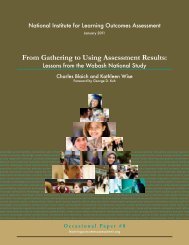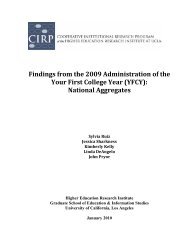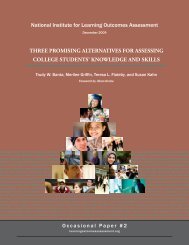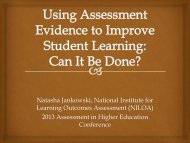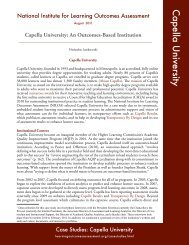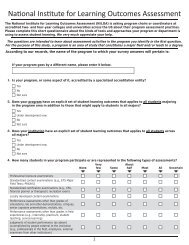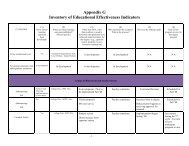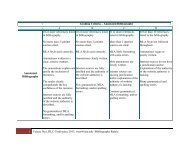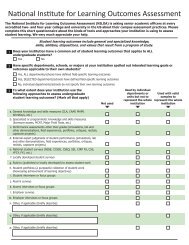Opening Doors to Faculty Involvement in Assessment - National ...
Opening Doors to Faculty Involvement in Assessment - National ...
Opening Doors to Faculty Involvement in Assessment - National ...
You also want an ePaper? Increase the reach of your titles
YUMPU automatically turns print PDFs into web optimized ePapers that Google loves.
These examples are still the exception, admittedly, but they show what is<br />
possible. Weav<strong>in</strong>g assessment <strong>in</strong><strong>to</strong> courses and experiences designed <strong>to</strong><br />
prepare beg<strong>in</strong>n<strong>in</strong>g scholars for their future work as educa<strong>to</strong>rs is a promis<strong>in</strong>g<br />
step forward, with long-term benefits as <strong>to</strong>day’s graduate students<br />
become <strong>to</strong>morrow’s faculty members and campus leaders.<br />
4. Reframe the Work of <strong>Assessment</strong> as Scholarship<br />
As scholars, faculty study all manner of artifacts and phenomena; their<br />
students’ learn<strong>in</strong>g should be seen as an important site for <strong>in</strong>vestigation,<br />
as well. Creat<strong>in</strong>g a place (and <strong>in</strong>centives) for greater faculty <strong>in</strong>volvement<br />
<strong>in</strong> assessment means see<strong>in</strong>g such work not simply as service or as<br />
good campus citizenship but as an important <strong>in</strong>tellectual enterprise—a<br />
form of scholarship reflect<strong>in</strong>g faculty’s professional judgment about the<br />
nature of deep understand<strong>in</strong>g of their field and about how such understand<strong>in</strong>g<br />
is developed.<br />
In this sense, assessment would do well <strong>to</strong> f<strong>in</strong>d common cause with<br />
the scholarship of teach<strong>in</strong>g and learn<strong>in</strong>g. This must be done carefully,<br />
given the different impulses and motivations beh<strong>in</strong>d each, but as noted<br />
above the two movements can strengthen each other. Thus, for starters,<br />
campus leaders of assessment and those charged with advanc<strong>in</strong>g the<br />
scholarship of teach<strong>in</strong>g and learn<strong>in</strong>g should explore shared agendas and<br />
practices. A parallel discussion between these two communities would<br />
be beneficial at the national level as well—for example, by <strong>in</strong>clud<strong>in</strong>g<br />
leaders from the scholarship of teach<strong>in</strong>g and learn<strong>in</strong>g community at<br />
assessment conferences, and vice versa.<br />
Beh<strong>in</strong>d many of the long-stand<strong>in</strong>g<br />
challenges of assessment is a<br />
more fundamental reality: that<br />
teach<strong>in</strong>g and learn<strong>in</strong>g have<br />
traditionally been seen and<br />
undertaken as private activities,<br />
occurr<strong>in</strong>g beh<strong>in</strong>d classroom doors<br />
both literally and metaphorically<br />
closed.<br />
Also needed is cont<strong>in</strong>ued attention <strong>to</strong> the development and use of new<br />
forms, formats, and genres for captur<strong>in</strong>g the scholarly work of teach<strong>in</strong>g,<br />
learn<strong>in</strong>g, and assessment. The course portfolio model mentioned above<br />
is perhaps pre-em<strong>in</strong>ent <strong>in</strong> this regard, with a grow<strong>in</strong>g community of<br />
users trad<strong>in</strong>g artifacts, review<strong>in</strong>g one another’s evidence and reflections,<br />
and putt<strong>in</strong>g their materials forward <strong>in</strong> both formative and summative<br />
decision-mak<strong>in</strong>g sett<strong>in</strong>gs (Bernste<strong>in</strong>, Burnett, Goodburn, & Savory,<br />
2006). But portfolios are only one possibility, and <strong>in</strong>vent<strong>in</strong>g other<br />
ways for faculty engaged <strong>in</strong> assessment—be it <strong>in</strong> their own classroom<br />
or beyond—<strong>to</strong> document and share their work <strong>in</strong> ways that can be<br />
reviewed, built on, and rewarded is a critical step forward that can help<br />
propel and reenergize the larger conversation about faculty roles and<br />
rewards.<br />
5. Create Campus Spaces and Occasions for Constructive<br />
<strong>Assessment</strong> Conversation and Action<br />
Beh<strong>in</strong>d many of the long-stand<strong>in</strong>g challenges of assessment is a more<br />
fundamental reality: that teach<strong>in</strong>g and learn<strong>in</strong>g have traditionally<br />
been seen and undertaken as private activities, occurr<strong>in</strong>g beh<strong>in</strong>d classroom<br />
doors both literally and metaphorically closed. As noted above,<br />
this reality has shifted significantly <strong>in</strong> recent years, as teach<strong>in</strong>g and<br />
learn<strong>in</strong>g have become <strong>to</strong>pics of widespread <strong>in</strong>terest, debate, and <strong>in</strong>quiry.<br />
Campuses seek<strong>in</strong>g <strong>to</strong> engage more faculty more deeply with assessment<br />
must f<strong>in</strong>d ways <strong>to</strong> create such opportunities—and there are now many<br />
possibilities and models.



